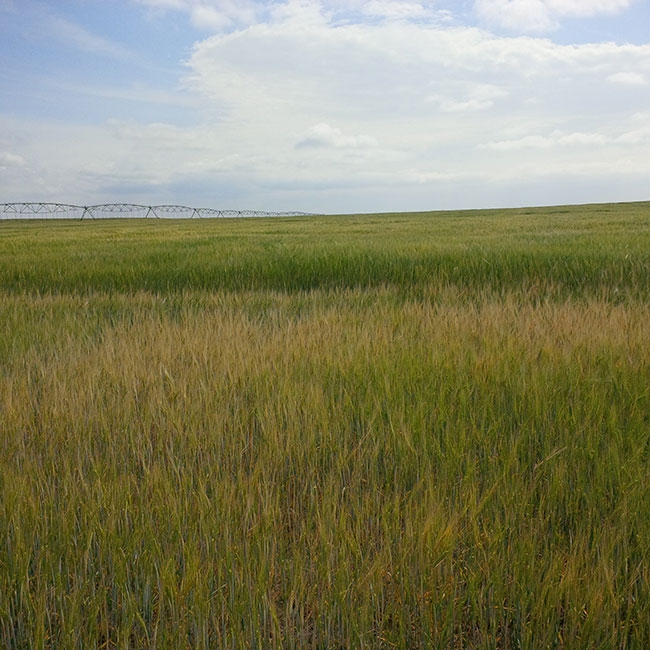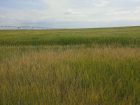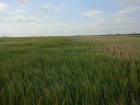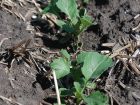
Features
Agronomy
Soil
Crop-water relations
High-yielding crops require large amounts of water during the growing season. A healthy, high-yielding wheat or canola crop requires up to 480 millimetres (mm) or 19 inches of water during the growing season. A good, average crop will take up 300 mm (12 inches) of water from the soil over the course of the growing season, which works out to about 2,718,000 lb/ac of water over the growing season.
May 10, 2018 By Ross H. McKenzie PhD P.Ag.
 The difference in water availability (irrigation versus no irrigation) caused visible distinctions in these two areas of the same barley field. High-yielding crops require large amounts of water during the growing season.
The difference in water availability (irrigation versus no irrigation) caused visible distinctions in these two areas of the same barley field. High-yielding crops require large amounts of water during the growing season.Water is required in far greater amounts than any other nutrient taken up from soil.
Crops need water for both growth and cooling. Crop water use can be determined on a daily, weekly or growing season basis.
A number of factors affect the amount of water used by a crop, including:
- crop type
- different stages of crop growth
- effective crop rooting depth
- amount of available water in soil
- precipitation during the growing season, and
- environmental factors including solar radiation, humidity, temperature and wind.
A prolonged water deficit will have a significant adverse effect on a crop growth and reduced yield potential.
Crop water use and evapotranspiration
Crop water use is referred to as evapotranspiration or ET. Evapotranspiration is the combination of water evaporation (E) from soil and plant surfaces, and water used by plants for growth and transpiration (T).
Transpiration refers to the water lost to the atmosphere through the stomata, which are small pores mostly on the undersides of plant leaves. Water released through the stomata keep plants cool to avoid heat stress. Evaporation losses are usually only significant when the soil surface is moist or when the crop canopy is wet, which occurs after precipitation or irrigation events. After the top two to four centimetres (cm) of surface soil have dried, evaporation of water from soil is usually minimal.
Evaporation from the soil surface is gradually reduced as the crop canopy closes in to completely shade the soil surface. At full crop canopy, almost all the ET is from transpiration by the crop.
Maximum ET rate occurs when soil water is not a limiting factor and crops are able to take up water to completely meet growth requirements and transpiration needs for keeping cool.
Crops utilize their root system to extract water from the soil. The rate and amount of water taken up by a crop is affected by the soil water content, stage of plant growth and effective rooting depth. Typically, barley, canola and wheat will root to about 100 cm to extract moisture, while pea typically will only root to about 75 cm.
The average daily amounts of ET for barley, canola, pea, and wheat during the growing season are provided in Figure 1. Daily crop water use is low at the beginning of the growing season and gradually increases as the crop develops through the various vegetative growth stages, peaks at reproductive growth and then gradually declines as the crop matures.
The approximate growing season water requirement for barley is 380 to 420 mm; canola requires 400 to 480 mm; pea requires 300 to 370 mm and spring wheat requires 420 to 480 mm, based on research in southern Alberta. These moisture-use curves and total crop water use values are based on adequate soil moisture conditions. Crop water use can be quite variable depending on environmental conditions. For example, wheat and canola water use can be 10 mm per day when air temperatures are over 30 C and the weather is sunny and windy.
Water use for vegetative growth
For annual crops such as barley, canola, pea and wheat, a certain amount of moisture is needed to initiate germination and take the crop through the vegetative growth stages. These four crops typically need at least 100 mm (four inches) and often closer to 125 mm (five inches) of water to get a crop from germination through to the start of reproductive growth stage. The amount of moisture needed during vegetative growth varies because crops do not need as much moisture for transpiration in a cooler spring compared to a warm, windy spring.
Most crops grown in Western Canada are cool season crops, with the exception of few crops, such as corn. For cool season crops, daytime high temperatures in the range of 20 C are ideal for growth. Under ideal temperature conditions, plants use soil moisture more efficiently for vegetative crop growth.
Cereal crops at tillering use about two to three mm of water per day, and at the stem elongation stage, need about three to five mm of water per day. When temperatures are above 25 C, the moisture needed is about five mm per day. On warm days at the stem elongation growth stage, a cereal crop will use about 20 to 35 mm of water in one week, depending on environmental conditions including solar radiation, temperature, humidity and wind.
When cereal crops are at the heading stage, water use is seven to eight mm per day under ideal conditions. This means that peak water use is substantial from mid-June to late July or early August for cereal crops. If moisture is lacking during this period, significant yield reduction can occur.
Water use for reproductive growth
Once a crop shifts from vegetative to reproductive growth, water use remains high. Cereal crops after heading and canola at the flowering growth stage will continue to use seven to eight mm of water per day from heading to flowering and to grain filling, under optimum growth conditions. But during this time, water use can be over 10 mm per day on very hot days. As grain filling nears completion, crop water use declines and drops off rapidly as plants approach maturity.
Alberta research has shown that under good environmental conditions, for each 25 mm (one inch) of water used during reproductive growth, wheat produces about five to eight bushels per acre, barley produces seven to 10 bushels per acre and canola produces 3.5 to five bushels per acre.
Effects of moisture stress on crops
The first effect of a moisture deficit condition during vegetative growth is a reduction in the growth rate of leaves and stems. When soil moisture availability becomes limited, cell expansion and division within the plant slows down and plants reduce the production of enzymes and proteins needed for growth.
As soil moisture deficiency increases, plant roots cannot take up enough water to meet transpiration needs of a crop to remain cool. Plant leaves show signs of wilting in mid-day heat. Crops respond to moisture stress by closing their stomata. As evening approaches, air temperatures cool down and solar radiation decreases. Plants gradually recover from mid-day wilting and stomata re-open to meet transpiration needs.
When wilting becomes more prolonged in cereal crops, older leaves and tillers are aborted and stem elongation is reduced. When wilting becomes more prolonged in oilseed crops, plants respond by abortion of older leaves, reduced stem elongation, reduced branching and flowers may be aborted, which reduce crop yield potential.
If the moisture deficiency becomes very advanced, wilting becomes more prolonged each day until plants reach a condition where recovery overnight does not occur, and plants will completely senesce and die.
Checking your soil moisture
It is wise for dryland farmers to develop a good understanding of how much water their soil types hold and learn how to check their soil moisture levels (refer to the story entitled Understanding water holding capacities of different soil types on page 18 of the March 2018 issue of Top Crop Manager West for more information).
Knowing soil moisture level relative to field capacity and wilting point is important to determine the plant available water content in soil. For farmers, the simplest and easiest way is using the hand-feel method to simply feel the soil to estimate how much water is in the soil.
Using a Dutch soil auger or soil probe, you can take soil samples from specific depths in the plant root zone and feel the soil to estimate the soil water content. Different soil textures have a unique feel with specific characteristics relative to the soil water content.
With experience, a farmer or agronomist can estimate a soil’s moisture content with reasonable accuracy. The United States Department of Agriculture has excellent information on using the hand-feel method to estimate soil moisture, available online at: www.nrcs.usda.gov/Internet/FSE_DOCUMENTS/nrcs144p2_051845.pdf.
Summary
Checking your soil moisture throughout the growing season and knowing how much water your crops are using on a daily basis can be very helpful when making decisions on in-crop nitrogen, plant growth regulators or fungicide treatments. When soil moisture conditions are good and crop water use is high, additional inputs can be very economical. But when available plant soil moisture levels are rapidly being depleted and crops cannot keep up with water requirements, additional inputs would likely not be beneficial.
Checking soil moisture, knowing as much as you can about your soil moisture conditions and crop water use, can be very helpful to estimate the benefit versus risk of additional in-crop inputs.



